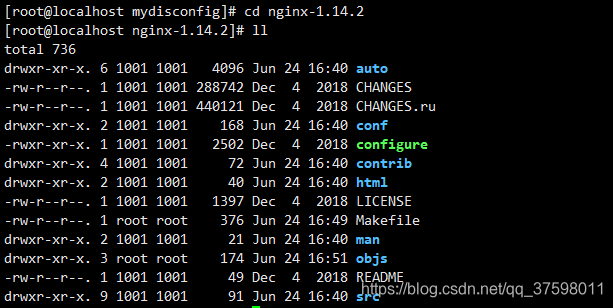Linux安装Nginx
本文共 590 字,大约阅读时间需要 1 分钟。
注:首先要安装这四个依赖:
yum -y install gcc zlib zlib-devel pcre-devel openssl openssl-devel
下载安装
下载
wget http://nginx.org/download/nginx-1.14.2.tar.gz
解压
tar zxvf nginx-1.14.2.tar.gz
编译安装
先cd进解压后的目录

然后先执行:
./configure
然后编译安装
makemake install

修改配置
vim /usr/local/nginx/conf/nginx.conf

将server中的listen改为8085.
启动
首先进入sbin目录,然后执行nginx
cd /usr/local/nginx/sbin./nginx
![]()
测试:curl localhost:8085

可以看到Nginx已经启动了,如果想外部访问则需要关闭防火墙:
systemctl stop iptables.service #centOS6及以前版本使用命令systemctl stop firewalld.service #centOS7关闭防火墙命令

常用命令:
./nginx #启动./nginx -s stop #关闭./nginx -s reload #重启
文档:
转载地址:http://bgmsz.baihongyu.com/
你可能感兴趣的文章
Nginx 相关介绍(Nginx是什么?能干嘛?)
查看>>
Nginx 知识点一网打尽:动静分离、压缩、缓存、跨域、高可用、性能优化...
查看>>
nginx 禁止以ip形式访问服务器
查看>>
NGINX 端口负载均衡
查看>>
Nginx 结合 consul 实现动态负载均衡
查看>>
Nginx 负载均衡与权重配置解析
查看>>
Nginx 负载均衡详解
查看>>
Nginx 负载均衡配置详解
查看>>
nginx 配置 单页面应用的解决方案
查看>>
nginx 配置dist 加上跨域配置
查看>>
nginx 配置https(一)—— 自签名证书
查看>>
nginx 配置~~~本身就是一个静态资源的服务器
查看>>
Nginx 配置服务器文件上传与下载
查看>>
Nginx 配置清单(一篇够用)
查看>>
Nginx 配置解析:从基础到高级应用指南
查看>>
Nginx 集成Zipkin服务链路追踪
查看>>
nginx 集群配置方式 静态文件处理
查看>>
Nginx+Django-Python+BPMN-JS的整合工作流实战项目
查看>>
Nginx+Keepalived+LVS集群实战
查看>>
Nginx+Keepalived实现简单版高可用主备切换
查看>>